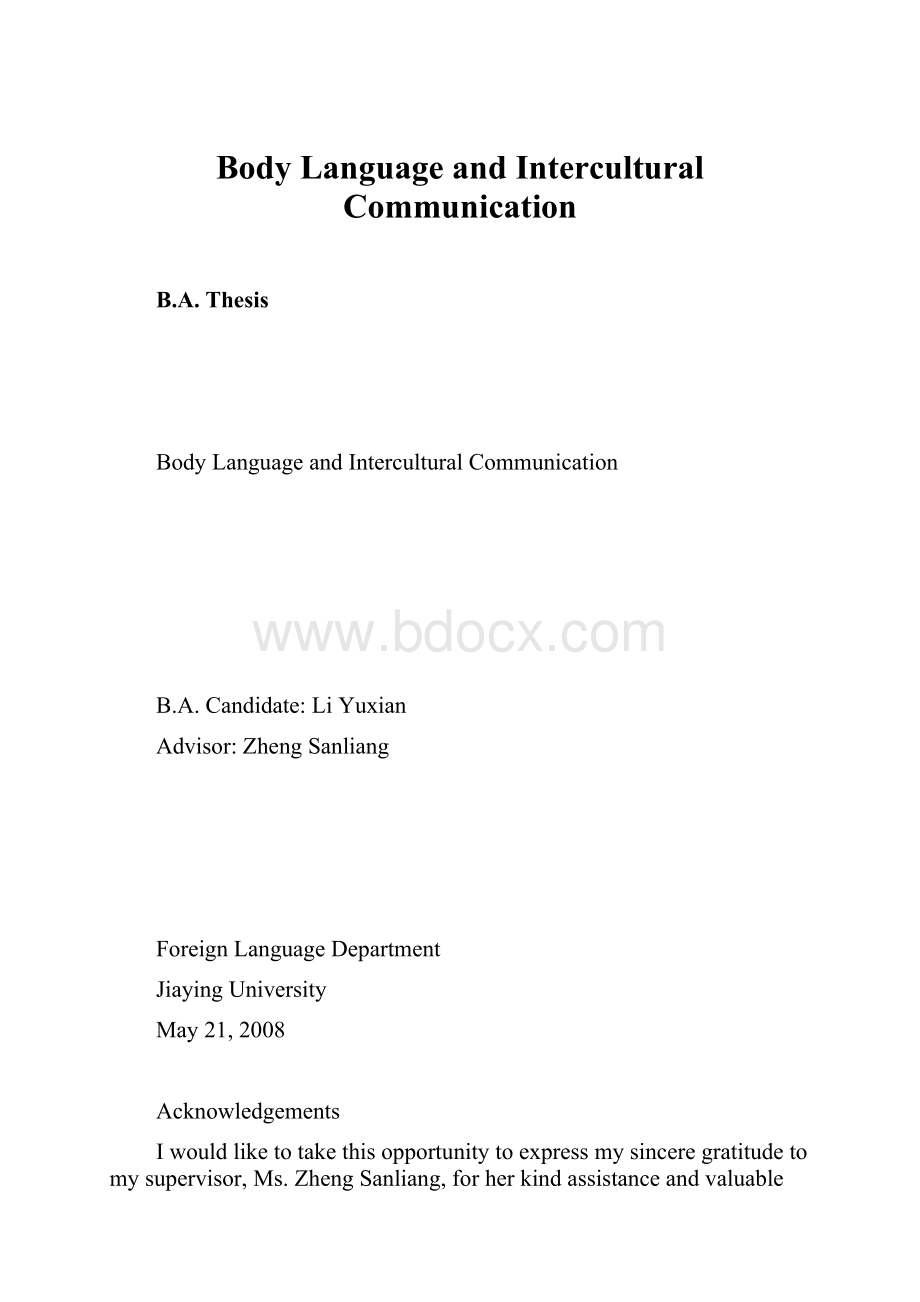Body Language and Intercultural Communication.docx
《Body Language and Intercultural Communication.docx》由会员分享,可在线阅读,更多相关《Body Language and Intercultural Communication.docx(21页珍藏版)》请在冰豆网上搜索。

BodyLanguageandInterculturalCommunication
B.A.Thesis
BodyLanguageandInterculturalCommunication
B.A.Candidate:
LiYuxian
Advisor:
ZhengSanliang
ForeignLanguageDepartment
JiayingUniversity
May21,2008
Acknowledgements
Iwouldliketotakethisopportunitytoexpressmysinceregratitudetomysupervisor,Ms.ZhengSanliang,forherkindassistanceandvaluableandinsightfulsuggestionsandconstructivecommentsduringtheprocessofmythesiswriting.Herwillingnesstogivehertimesogenerouslyhasbeenverymuchappreciated.
Mygratitudealsoextendstoalltheteacherswhotaughtmeduringmyundergraduateyearsfortheirkindencouragementandpatientinstructions.AspecialacknowledgementshouldbeshowntoMr.TianMinggangwhotaughtushowtodothereferencelastterm.Moreover,IwishtoextendmythankstotheForeignLanguageDepartmentforthereferenceroomwhereIfoundtheimportantinformation,andthelibraryassistantwhohelpedtosuppliedmewithreferencematerialsofgreatvalue.
Lastbutnottheleast;Iwouldliketooffermyparticularthankstomyfriendsandfamily,fortheirencouragementandsupportforthecompletionofthisthesis.
Abstract
Thepapermakesamainstudyonbodylanguage,themostimportantpartofnonverbalcommunication,fromtheperspectiveofinterculturalcommunication.Inhumancommunication,peopleusebodylanguagetocommunicateaswellasverballanguage.BodylanguageisalsocalledKinesics.Itbelongstothescopeofnonverbalcommunication.Bodylanguageplaysanimportantroleinrepeating,complementing,substituting,regulatingandcontradicting.Bodylanguage,likeverballanguage,isalsoapartofculture.Butindifferentculturesbodylanguagemeansthedifferentthings.Differentpeoplehavedifferentwaysofmakingnonverbalcommunication.Ininterculturalcommunication,understandingthedifferentculturalimplicationofChineseandEnglishbodylanguagecanpromotepeople’scross-culturalcommunicationcompetence,reinforcetheheart-to-heartunderstandingandintheendwillbenefitthecommunicationbetweenChineseandEnglishpeople.
Thispapermainlyexpoundsthedefinition,classificationandfunctionsofbodylanguageinpragmatics,presentsthemeaningsofbodylanguageindifferentculturesfromthepointofcultures,researchesbodylanguage’sculturaldifferencesbetweenChineseandEnglish,especiallythoseingesture,posture,facialexpression,eyecontactandphysicaldistance,anddiscussestheimportanceofknowingculturalmeanings.TheresearchofChineseandEnglishbodylanguageinnonverbalcommunicationishelpfulforpeopletodiminishoravoidmisunderstandingscausedbytheculturaldifferencesofbodylanguage.
KeyWords:
bodylanguagefunctioninterculturalcommunicationculturaldifferences
摘要
本文从跨文化交际角度对非言语交际的主要方式---体态语进行可初步研究。
人们在进行交流的过程中,除了运用语言这种普遍的方式外,也经常运用身势语。
身势语又称体态语,是人类交际中最常见的一种非语言交际手段。
身势语对话语意义起着重复、补助、替代、调节、否定作用。
身势语同语言一样,都是文化的一部分。
在不同文化中,身势语的意义并不完全相同。
各个民族有不同的非语言交际方式。
在跨文化交际中,了解汉英身势语的不同文化内涵,有助于汉英国家的人民之间更好地交流,提高跨文化交际能力,增进感情与心态的理解,做到“入乡随俗”,传情达意。
本文重点论述了身势语的定义、类型和功能,并从文化角度对身势语在不同的文化背景中的含义作了介绍,探讨了中国和英语国家在手势,姿态,面部表情,眼神与体距等方面的文化差异,论述了了解文化含义在非语言交际中的重要性。
对跨文化交际中的英汉体态语进行探讨,有助于人们减少或避免在跨文化交际中因体态语的文化差异而引起的误解。
关键词:
身势语功能跨文化交际文化差异
Contents
Acknowledgements……………………………………………………..……………i
Abstract(English)………………………………………………..…………………...ii
Abstract(Chinese)……………………………………………………..…………….iv
1.Introduction………………………………………………………………………..1
2.Bodylanguage………………………..….………………………………………...2
2.1Definition……………………….…………………………………………….2
2.2Classificationofbodylanguage……………………………………………….2
2.2.1.Facialexpressions……………………………………………………….2
2.2.2.Eyebehavior…………………………………………………………….3
2.2.3.Gestures…………………………………………………………………4
2.2.4.Posture…………………………………………………………………..4
3.Pragmaticfunctionsofbodylanguage…………………………………………….5
3.1Repeating……………………………………………………………………...6
3.2Complementing………………………………………………….……………6
3.3Substituting…………………………………………………………………...7
3.4Regulating…………………………………………………………………….7
3.5Contradicting……………………………………………………………........7
4.AcomparativestudyofChineseandEnglishbodylanguage…………………….8
4.1Gestures………..………………………….…………………………………...10
4.1.1Thesamegesturewithdifferentmeaningsindifferentcultures………...10
4.1.2Differentgestureswithsamemeaning…………………………………..12
4.1.3Gestureandmeaninginoneculturewithoutequivalentinothercultures13
4.2Posture…………..……..……………..............................................................14
4.3Facialexpression……………………………………………………………..15
4.4Eyecontact………………………………………….......................................17
4.5Physicaldistance……………………………………………………………..20
5.Conclusion………………………………………………………………………..22
References………………………………………………………………..…………25
BodyLanguageandInterculturalCommunication
1.Introduction
Interculturalcommunicationistheprocessofcommunicationbetweenpeoplefromdifferentculturalbackgrounds.Itcanbedividedintotwotypes:
verbalcommunicationandnon-verbalcommunication.Peoplecancommunicatewithoneanothernotonlythroughverbalcommunicationbutalsothroughnonverbalcommunication;moreover,thelatterplaysanessentialroleandmainlyexpressesrealemotionandattitudethroughfacialexpression,posture,eyebehavior,clothes,sound,etc.Bodylanguageisanimportantpartofnonverbalcommunication,andthusthispaperintendstopresentitsmeaningandclassification,pragmaticfunctionsandculturaldifferencessothatwecanimproveourcommunicationskillsandabilitiesbyunderstandingitwell.
Asthetrendofglobalizationisstrengthenedstepbystep,internationalcommunicationisfrequentandimportantdaybyday.Thus,thesignificanceofbodylanguageininterculturalcommunicationhasbeengreatlyrealized.“Researchshowsthatwhenpeoplemeetsomeoneforthefirsttime,only7%oftheirinitialimpactonothersisdeterminedbythecontentofwhattheysay;theother93%oftheirmessageismadeupofbodylanguage(55%)andthetoneoftheirvoice(38%).”(ZhangJianqing,2004:
105).Bodylanguageisalsointerlinkedwithspokenlanguageandawholepatternofbehaviorfromaperson.Aswellasthat,variousbodylanguagesignscancomplementeachothertomakeaparticularmeaningcrystalclearorstrengthenthemeaningofwhatwecommunicate.
Owingtoculturaldifferences,thesamebodylanguagehasdifferentmeaningsandcommunicativefunctions,whichcausesalotoftroubleininterculturalcommunication.Therefore,ininterculturalcommunication,itisofgreatimportanceforustounderstandthebodylanguage.ThispaperfocusesontheculturalcomparisonofthebodylanguagebetweenChineseandEnglish.
2.Bodylanguage
2.1Definition
Therearedifferentversionsmadebydifferentresearcherstothedefinitionsofbodylanguagewhicharepresentedasinordertosetamuchclearerpictureofit:
a).“Bodylanguageisnotconveyedthroughwords.Itisakindofman'ssocialattributesandbehavior.Whichareissuedbythedeliverer,andreceivedbythereceivedpurposely.”(Burgoonandsaine,1978:
89)b).AccordingtoBirdwhistell,anAmericanpsychologist,whoisthefirstpersonthatcreatedthedefinitionof“bodylanguage”,“bodylanguageisalsocalledkinesics,includingeyecontact,gestures,posture,facialexpressions,andphysicaldistance.”(JiaYuxin,1997:
68)C).Chinesefamousscholar,ChenWangdaooncegavebodylanguagethefollowingdefinition,“theactionofstrikingaposeisbodylanguage,whichisatoolforcommunication.”(ChenWangdao,1979:
21)
Basedontheprecedingdefinitionsabove,itcanbeseenthatdifferentresearchersviewbodylanguagefromdifferentstandpoints,eachdefinitionofbodylanguageisrepresentedfromlevelsofthelanguage.However,theyhaveonepointincommonthatbodylanguagereferstothoseappearancesandactionstransmittingcommunicationinformation.Itisthereflectingornonreflectingactionsmadebythewholebodyorjustpartsofthebody,throughwhichtocommunicativewiththeobjectiveworld.
2.2Classificationofbodylanguage
Bodylanguageistherichestkindinallkindsofnonverballanguages,itisestimatedthathumancandomorethan270,000kindsofposturesandactions,whicharemorethanallthesoundstheycanmade.Andeachpartofbodylanguagacttioncanconveydifferentmeaningaswellassounds.Therefore,peopleexpresstheiremotionsandattitudesbyusingkindsofbodylanguages.Accordingtothedifferentactionsofhuman’sbody,bodylanguagecanbeclassifiedintofourcategories:
facialexpressions,eyebehavior,gestures,posture.
2.2.1Facialexpressions
Thefacehasbeencalledan“organofemotion”becauseitisaverycommonwaythatpeopleusetocommunicateandconstantlytounderstandwhatothersarefeelingeveryday,suchas,peoplemakeabigsmileontheirfacewhentheyfeelveryhappy,whereas,theymakealongfacewhentheyfellunhappy.Comparedwithwords,facialexpressionisanaturalwaytorevealperson’semotionanditoffersvitalcluestopeople’sownfeeling.
Inmostcultures,ingeneral,asmileisasignofhappinessorfriendlyaffirmation,asinAmericaandChina.It’softenfoundthatotherswillreturnasmiletothosewhosmileatthembutwilllookawayorstopspeakingtothepersonwhoselipsarepursedinfrown.Thiscanwellbeusedinbusiness.Forexample,iftheshopkeeperfacestheircustomerswithcoldnessandindifference,pullingalongfacethathidesmutualinformationofcommunication,it’sverylikelythatthecustomerswillbekeptawayfromtheirservice.Themannersoftreatingpeoplewithsincerity,ofservingpeoplewithabigsmilemakepeoplefeelcordialandwarm.
2.2.2Eyebehavior
Eyebehaviorisanimp